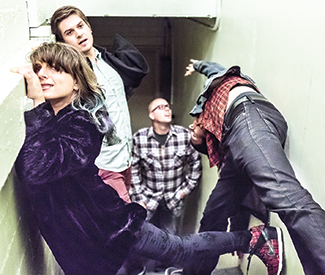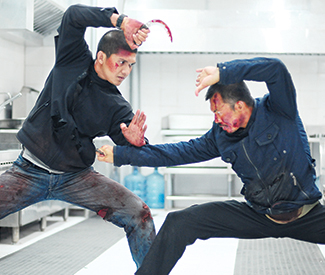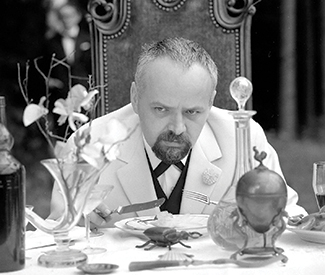WEDNESDAY 2
ROCK
Bottom of the Hill: 1233 17th St., San Francisco. Middlesleep, Halsted, Cazadero, 9pm, $8.
El Rio: 3158 Mission, San Francisco. Jet Trash, The Nurseries, Yet, The Riders, 8pm, $6.
Elbo Room: 647 Valencia, San Francisco. Sean O’Brien & His Dirty Hands, Spider Heart, New American Farmers, 9pm, $8.
The Independent: 628 Divisadero, San Francisco. EMA, Mas Ysa, 8pm, $15.
Milk Bar: 1840 Haight, San Francisco. Down Dirty Shake, The Love Dimension, Buzzmutt, Talk of Shamans, DJ Darragh Skelton, 8pm, $5.
Rickshaw Stop: 155 Fell, San Francisco. Be Calm Honcho, The She’s, Owl Paws, 8pm, $10.
DANCE
Beaux: 2344 Market, San Francisco. “BroMance: A Night Out for the Fellas,” 9pm, free.
The Cafe: 2369 Market, San Francisco. “Sticky Wednesdays,” w/ DJ Mark Andrus, 8pm, free.
Cat Club: 1190 Folsom, San Francisco. “Bondage-A-Go-Go,” w/ DJ Damon, Tomas Diablo, guests, 9:30pm, $7-$10.
Club X: 715 Harrison, San Francisco. “Electro Pop Rocks: EPR USA,” 18+ dance night with Far Too Loud, 9pm
F8: 1192 Folsom, San Francisco. “Housepitality,” w/ King Britt, Fil Latorre, Mike Bee, 9pm, $5-$10.
Infusion Lounge: 124 Ellis, San Francisco. “Indulgence,” 10pm
Lookout: 3600 16th St., San Francisco. “What?,” 7pm, free.
Madrone Art Bar: 500 Divisadero, San Francisco. “Rock the Spot,” 9pm, free.
MatrixFillmore: 3138 Fillmore, San Francisco. “Reload,” w/ DJ Big Bad Bruce, 10pm, free.
Monarch: 101 Sixth St., San Francisco. “Advance,” w/ Flaco, Tchphnx, Professor Bang, Shadow Spirit, Joe Mousepad, 9pm, $5 (free before 10pm).
Q Bar: 456 Castro, San Francisco. “Booty Call,” w/ Juanita More, 9pm, $3.
HIP-HOP
Brick & Mortar Music Hall: 1710 Mission, San Francisco. Evenodds, Equipto, DJ H Holla, 10pm, $10-$15.
Skylark Bar: 3089 16th St., San Francisco. “Mixtape Wednesday,” w/ resident DJs Strategy, Junot, Herb Digs, & guests, 9pm, $5.
ACOUSTIC
Cafe Divine: 1600 Stockton, San Francisco. Craig Ventresco & Meredith Axelrod, 7pm, free.
Fiddler’s Green: 1333 Columbus, San Francisco. Terry Savastano, Every other Wednesday, 9:30pm, free/donation.
Hotel Utah: 500 Fourth St., San Francisco. Karmen Buttler, Bekah Barnett, 8pm, $10.
Plough & Stars: 116 Clement, San Francisco. Jeanie & Chuck’s Bluegrass Country Jam, First Wednesday of every month, 9pm, free.
JAZZ
Amnesia: 853 Valencia, San Francisco. Gaucho, Eric Garland’s Jazz Session, The Amnesiacs, 7pm, free.
Balancoire: 2565 Mission, San Francisco. “Cat’s Corner,” 9pm, $10.
Burritt Room: 417 Stockton St., San Francisco. Terry Disley’s Rocking Jazz Trio, 6pm, free.
Cafe Claude: 7 Claude, San Francisco. The Monroe Trio, 7:30pm, free.
Jazz Bistro at Les Joulins: 44 Ellis, San Francisco. Charles Unger Experience, 7:30pm, free.
Le Colonial: 20 Cosmo, San Francisco. The Cosmo Alleycats featuring Ms. Emily Wade Adams, 7pm, free.
Level III: 500 Post, San Francisco. Sony Holland, Wednesdays-Fridays, 5-8pm, free.
Pier 23 Cafe: Pier 23, San Francisco. Gary Zellerbach, 6pm, free.
Revolution Cafe: 3248 22nd St., San Francisco. Michael Parsons, First Wednesday of every month, 9pm
Savanna Jazz Club: 2937 Mission, San Francisco. Savanna Jazz Jam with Eric Tillman, 7pm, $5.
Top of the Mark: One Nob Hill, 999 California, San Francisco. Ricardo Scales, Wednesdays, 6:30-11:30pm, $5.
Zingari: 501 Post, San Francisco. Anne O’Brien, First Wednesday of every month, 7:30pm, free.
INTERNATIONAL
Bissap Baobab: 3372 19th St., San Francisco. “Baobab!,” timba dance party with DJ WaltDigz, 10pm, $5.
Cafe Cocomo: 650 Indiana, San Francisco. “Bachatalicious,” w/ DJs Good Sho & Rodney, 7pm, $5-$10.
Make-Out Room: 3225 22nd St., San Francisco. “Frigo-Bar,” First Wednesday of every month, 9pm, free.
BLUES
Biscuits and Blues: 401 Mason, San Francisco. Eddie Neon, 7:30 & 9:30pm, $15.
Union Square Park: 333 Post, San Francisco. Dr. Mojo, 6pm, free.
SOUL
Monarch: 101 Sixth St., San Francisco. “Color Me Badd,” coloring books and R&B jams with Matt Haze, DJ Alarm, Broke-Ass Stuart, guests, Wednesdays, 5:30-9:30pm, free.
THURSDAY 3
ROCK
Bottom of the Hill: 1233 17th St., San Francisco. Marine Life, Whiskerman, Mild Meddle, 9pm, $8.
Brick & Mortar Music Hall: 1710 Mission, San Francisco. Sit Kitty Sit, Bent Knee, Strange Hotel, 9pm, $7-$10.
The Chapel: 777 Valencia, San Francisco. Phox, 9pm, $12.
Hemlock Tavern: 1131 Polk, San Francisco. Male Gaze, Thunders, Pat Thomas, 8:30pm, $6.
Make-Out Room: 3225 22nd St., San Francisco. Swiftumz, Dirty Ghosts, DJ Foodcourt, 7:30pm, $8.
Milk Bar: 1840 Haight, San Francisco. The Burning of Rome, The Bixby Knolls, Kingsborough, 8:30pm, $5.
DANCE
1015 Folsom: 1015 Folsom, San Francisco. “The Big Bang,” w/ Giraffage, Crnkn, Jacuzzi, Pumpkin, The Human Experience, Nico Luminous, DJ Dials, Insightful, Releece, Getright, Chad Salty, more, 10pm, $20 advance.
Abbey Tavern: 4100 Geary, San Francisco. DJ Schrobi-Girl, 10pm, free.
Aunt Charlie’s Lounge: 133 Turk, San Francisco. “Tubesteak Connection,” w/ DJ Bus Station John, 9pm, $5-$7.
Beaux: 2344 Market, San Francisco. “Twerk Thursdays,” 9pm, free.
The Cafe: 2369 Market, San Francisco. “¡Pan Dulce!,” 9pm, $5.
Cat Club: 1190 Folsom, San Francisco. “Class of 1984,” ‘80s night with DJs Damon, Steve Washington, Dangerous Dan, and guests, 9pm, $6 (free before 9:30pm).
The Cellar: 685 Sutter, San Francisco. “XO,” 10pm, $5.
Club X: 715 Harrison, San Francisco. “The Crib,” 18+ LGBT dance party, 9:30pm, $10.
The Cosmo Bar & Lounge: 440 Broadway, San Francisco. “Thumpday Thursday,” 9:30pm, $10.
Elbo Room: 647 Valencia, San Francisco. “Hi Life,” w/ resident DJs Pleasuremaker & Izzy*Wize, 9:30pm, $6.
F8: 1192 Folsom, San Francisco. “Beat Church,” w/ resident DJs Neptune & Kitty-D, First Thursday of every month, 10pm, $10.
Harlot: 46 Minna, San Francisco. “#Y2KTHURS,” w/ DJ Mei-Lwun, 9pm, free.
Infusion Lounge: 124 Ellis, San Francisco. “I Love Thursdays,” 10pm, $10.
Madrone Art Bar: 500 Divisadero, San Francisco. “Night Fever,” 9pm, $5 after 10pm
Monarch: 101 Sixth St., San Francisco. “As You Like It,” w/ Marcel Fengler, Sigha, Mossmoss, Brian Knarfield, 9pm, $15-$25.
OMG: 43 Sixth St., San Francisco. “Techno Fun,” w/ Lisa Rose, Mozaic, Lt. Daaan, 9pm, $5.
Raven: 1151 Folsom, San Francisco. “1999,” w/ VJ Mark Andrus, 8pm, free.
Rickshaw Stop: 155 Fell, San Francisco. “Popscene,” w/ Tove Lo, Aaron Axelsen, Miles the DJ, 9pm, sold out.
Ruby Skye: 420 Mason, San Francisco. “Torq,” w/ Autoerotique, 9pm, $10-$25.
Temple: 540 Howard, San Francisco. Pre-Independence Day Party, 18+ dance night with Discopill, Matt Haze, Neon Neo, DJ Imani, 10pm, $10 (free before midnight with RSVP).
Trax: 1437 Haight, San Francisco. “Beats Reality: A Psychelelic Social,” w/ resident DJs Justime & Jim Hopkins, 9pm, free.
Underground SF: 424 Haight, San Francisco. “Bubble,” 10pm, free.
Vessel: 85 Campton, San Francisco. “Big Fun,” w/ Ejeca, 10pm, $5-$10.
HIP-HOP
John Colins: 138 Minna, San Francisco. “Future Flavas,” w/ DJ Natural, 10pm, free.
Mezzanine: 444 Jessie, San Francisco. “Cream of Beat,” w/ Keith Murray, JT the Bigga Figga, Mind Motion, Ivan, Dark Money, Apollo, Mr. E, D-Sharp, Miles Medina, Remedy, 9pm, $20-$50.
Skylark Bar: 3089 16th St., San Francisco. “Peaches,” w/ lady DJs DeeAndroid, Lady Fingaz, That Girl, Umami, Inkfat, and Andre, 10pm, free.
ACOUSTIC
Amnesia: 853 Valencia, San Francisco. The Blue Ribbon Healers, Western Justice, Misisipi Mike & The Midnight Gamblers, 9pm, $7.
Atlas Cafe: 3049 20th St., San Francisco. Bermuda Grass, 8pm, free.
Bazaar Cafe: 5927 California, San Francisco. Acoustic Open Mic, 7pm
Hotel Utah: 500 Fourth St., San Francisco. Songwriters in the Round with Heather Combs, Melissa Phillips & James DePrato, James Nash, Anne Heaton, 8pm, $8.
Musicians Union Local 6: 116 Ninth St., San Francisco. San Francisco Singer-Songwriters’ Workshop, hosted by Robin Yukiko, First Thursday of every month, 6:30pm, $25 (free for AFM members).
Plough & Stars: 116 Clement, San Francisco. The Shannon Céilí Band, First Thursday of every month, 9pm, free.
Red Poppy Art House: 2698 Folsom, San Francisco. Ila Cantor, Jacob Aranda, 7:30pm, $15-$20.
JAZZ
Cafe Claude: 7 Claude, San Francisco. Marcus Shelby Trio, 7:30pm, free.
Jazz Bistro at Les Joulins: 44 Ellis, San Francisco. Eugene Pliner Quartet with Tod Dickow, First and Third Thursday of every month, 7:30pm, free.
Le Colonial: 20 Cosmo, San Francisco. Steve Lucky & The Rhumba Bums, 7:30pm
Level III: 500 Post, San Francisco. Sony Holland, Wednesdays-Fridays, 5-8pm, free.
Pier 23 Cafe: Pier 23, San Francisco. Snakebite & Friends, 7pm, free.
The Royal Cuckoo: 3202 Mission, San Francisco. Charlie Siebert & Chris Siebert, 7:30pm, free.
Savanna Jazz Club: 2937 Mission, San Francisco. Savanna Jazz Jam with Eric Tillman, 7pm, $5.
Top of the Mark: One Nob Hill, 999 California, San Francisco. Pure Ecstasy, 7:30pm, $10.
Yoshi’s San Francisco: 1330 Fillmore, San Francisco. David Murray Infinity Quartet, 8 & 10pm, $19-$28.
INTERNATIONAL
Blush! Wine Bar: 476 Castro, San Francisco. Americano Social Club, 7:30pm, free.
Roccapulco Supper Club: 3140 Mission, San Francisco. Avance, 8pm
Sheba Piano Lounge: 1419 Fillmore, San Francisco. Gary Flores & Descarga Caliente, 8pm
Verdi Club: 2424 Mariposa, San Francisco. The Verdi Club Milonga, w/ Christy Coté, DJ Emilio Flores, guests, 9pm, $10-$15.
Yerba Buena Gardens: Fourth St. & Mission, San Francisco. Les Gwan Jupons, 12:30pm, free.
REGGAE
Pissed Off Pete’s: 4528 Mission St., San Francisco. Reggae Thursdays, w/ resident DJ Jah Yzer, 9pm, free.
BLUES
50 Mason Social House: 50 Mason, San Francisco. Bill Phillippe, 5:30pm, free.
Biscuits and Blues: 401 Mason, San Francisco. Cole Fonseca, 7:30 & 9:30pm, $15.
The Saloon: 1232 Grant, San Francisco. Chris Ford, First Thursday of every month, 4pm
COUNTRY
McTeague’s Saloon: 1237 Polk, San Francisco. “Twang Honky Tonk,” w/ Sheriff Paul, Deputy Saralynn, and Honky Tonk Henry, 7pm
The Parlor: 2801 Leavenworth, San Francisco. “Honky Tonk Thursdays,” w/ DJ Juan Burgandy, 9pm, free.
EXPERIMENTAL
Center for New Music: 55 Taylor, San Francisco. Of Land & Sea: Natural-Object Instruments by Cheryl Leonard, 6pm, free.
The Luggage Store: 1007 Market, San Francisco. Earth Blind, The Norman Conquest, 8pm, $6-$10.
ROCKABILLY
Tupelo: 1337 Green, San Francisco. Whisky Pills Fiasco, First Thursday of every month, 9pm
SOUL
The Independent: 628 Divisadero, San Francisco. Young & Sick, 8pm, $12-$14.
FRIDAY 4
ROCK
Amnesia: 853 Valencia, San Francisco. Should We Run, 7pm, free.
Bottom of the Hill: 1233 17th St., San Francisco. Cuban Cigar Crisis, The Record Winter, Panic Is Perfect, 9pm, $8.
El Rio: 3158 Mission, San Francisco. Ninth Annual El Rio Big Time Freedom Fest, With Golden Void, Bobb Saggeth, Once & Future Band, and Fine Points., 2pm, $8.
Hemlock Tavern: 1131 Polk, San Francisco. The Old Firm Casuals, Pressure Point, Roadside Bombs, 5pm, $12; The Chuckleberries, Thunderroads, 10pm, $5.
Milk Bar: 1840 Haight, San Francisco. The American Professionals, When Particles Collide, The Honey Wilders, 8:30pm, $5.
Thee Parkside: 1600 17th St., San Francisco. Thee Parkside’s Lowdown Throwdown, With Chrome Eagle, Dirty Denim, The Yes-Go’s, DJ Longshot, tricycle races, arm wrestling, and more., 1pm, free.
DANCE
1015 Folsom: 1015 Folsom, San Francisco. Protoculture & Shogun, w/ Taj, Blurr, Meikee Magnetic, MytyMyke, Adam Cova, Kepik, NovaSpace, Non Sequitur, Mario Mar, more, 10pm, $20-$25 advance.
Amnesia: 853 Valencia, San Francisco. “Brass Tax,” w/ resident DJs JoeJoe, Ding Dong, Ernie Trevino, Mace, First Friday of every month, 10pm, $5.
Audio Discotech: 316 11th St., San Francisco. Grum, Kirin Rider, Grensta, 9:30pm, $10 advance.
Beaux: 2344 Market, San Francisco. “Manimal,” 9pm
The Cafe: 2369 Market, San Francisco. “Boy Bar,” 9pm, $5.
Cat Club: 1190 Folsom, San Francisco. “Strangelove: Military Fashion Show,” w/ DJs Tomas Diablo, Lexor, Xander, and Fact.50, 9:30pm, $8 ($5 before 10pm).
The Cellar: 685 Sutter, San Francisco. “F.T.S.: For the Story,” 10pm
DNA Lounge: 375 11th St., San Francisco. “So Stoked: ‘Merica! Fuck Yeah!,” w/ Luna-C, Rhythmics, No Left Turn, Tranz Am, Rafer Rawb, Anglerfish, Darko, DJ Carrotkore, 7pm, $10-$20.
The EndUp: 401 Sixth St., San Francisco. “Trade,” 10pm, free before midnight.
The Grand Nightclub: 520 Fourth St., San Francisco. “We Rock Fridays,” 9:30pm
Infusion Lounge: 124 Ellis, San Francisco. “Flight Fridays,” 10pm, $20.
Lookout: 3600 16th St., San Francisco. “HYSL: Handle Your Shit Lady,” 9pm, $3.
Madrone Art Bar: 500 Divisadero, San Francisco. “Dirty Rotten Dance Party,” w/ Kap10 Harris, Shane King, guests, First Friday of every month, 9pm, $5.
MatrixFillmore: 3138 Fillmore, San Francisco. “F-Style Fridays,” w/ DJ Jared-F, 9pm
Mercer: 255 Rhode Island, San Francisco. “All of the Above,” w/ King Most, Freddy Anzures, Marky, First Friday of every month, 9pm, $10 (free before 10pm).
Mezzanine: 444 Jessie, San Francisco. “Future Fridays,” w/ Kill Paris, TastyTreat, Tech Minds, 9pm, $15.
Mighty: 119 Utah, San Francisco. “Heart Phoenix: Independance,” w/ Justin Jay, Daniel Dubb, David Hohme, Derek Hena, Bo, Deckard, Boris Levit, Josh Vincent, Vitamindevo, Zita Molnar, Alastair,am Rebel, 9pm, $10-$15 advance.
Monarch: 101 Sixth St., San Francisco. “Green Gorilla 4th of July,” w/ Sleight of Hands, Shiny Objects, Bells & Whistles, Joey Alaniz, Jamie James, Joel Conway, Kimmy Le Funk, Mr. Perry, 9pm, $10.
Neck of the Woods: 406 Clement, San Francisco. “That ‘80s Show,” w/ DJ Dave Paul (downstairs), First Friday of every month, 8pm, $5.
OMG: 43 Sixth St., San Francisco. “Deep Inside,” 9pm, free.
Powerhouse: 1347 Folsom, San Francisco. “Nasty,” First Friday of every month, 10pm, $5.
Q Bar: 456 Castro, San Francisco. “Pump: Worq It Out Fridays,” w/ resident DJ Christopher B, 9pm, $3.
Temple: 540 Howard, San Francisco. Independence Day with Monika, DJ Rose, Reflecta, Deejay Tone, 10pm, $15.
Treasure Island Event Venue: 401 California Ave., San Francisco. “Independence Island: 4th of July Raveolution Massive,” 18+ dance party with G. Jones, Sam F, Entyme, SwitchBlade, Carlos Alfonzo, Infusion, Omega, Linx, Nico Crispy, Ross.FM, Frank Nitty, more, 9pm, $15+ advance.
Vessel: 85 Campton, San Francisco. Maor Levi, SNR, Daun Giventi, 10pm, $10-$30.
HIP-HOP
DNA Lounge: 375 11th St., San Francisco. “Indepen-DANCE Day,” w/ DJs Dave Paul, Myster C, and Mr. Washington, 9pm, $5 advance.
EZ5: 682 Commercial, San Francisco. “Decompression,” Fridays, 5-9pm
Manor West: 750 Harrison, San Francisco. “Popular Demand: July 4th Takeover,” w/ P-Lo, DJ ASAP, Caprise, 10pm, $20.
ACOUSTIC
The Sports Basement: 610 Old Mason, San Francisco. “Breakfast with Enzo,” w/ Enzo Garcia, 10am, $5.
St. Cyprian’s Episcopal Church: 2097 Turk, San Francisco. First Fridays Song Circle, First Friday of every month, 7pm, $5-$10.
JAZZ
Atlas Cafe: 3049 20th St., San Francisco. The Emergency Ensemble, First Friday of every month, 7:30pm, free.
Bird & Beckett: 653 Chenery, San Francisco. Don Prell’s SeaBop Ensemble, First Friday of every month, 5:30pm, $10 suggested donation per adult.
Cliff House: 1090 Point Lobos, San Francisco. John Kalleen Group, First Friday of every month, 7pm
Jazz Bistro at Les Joulins: 44 Ellis, San Francisco. Charles Unger Experience, 7:30pm, free.
Level III: 500 Post, San Francisco. Sony Holland, Wednesdays-Fridays, 5-8pm, free.
The Royale: 800 Post, San Francisco. Wrapped in Plastic, First Friday of every month, 9pm, free.
Savanna Jazz Club: 2937 Mission, San Francisco. Savanna Jazz Trio with Eric Tillman, 7:30pm, $8.
Top of the Mark: One Nob Hill, 999 California, San Francisco. Black Market Jazz Orchestra, 9pm, $10.
Zingari: 501 Post, San Francisco. Joyce Grant, 8pm, free.
INTERNATIONAL
Bissap Baobab: 3372 19th St., San Francisco. “Paris-Dakar African Mix Coupe Decale,” 10pm, $5.
Cafe Cocomo: 650 Indiana, San Francisco. Taste Fridays, featuring local cuisine tastings, salsa bands, dance lessons, and more, 7:30pm, $15 (free entry to patio).
Elbo Room: 647 Valencia, San Francisco. “Copa,” w/ DJs Vanka, Zamba, and Elan, 10pm, $5-$10.
Pachamama Restaurant: 1630 Powell, San Francisco. Cuban Night with Fito Reinoso, 7:30 & 9:15pm, $15-$18.
Roccapulco Supper Club: 3140 Mission, San Francisco. Fuego Latino, 9pm
REGGAE
Gestalt Haus: 3159 16th St., San Francisco. “Music Like Dirt,” 7:30pm, free.
Showdown: 10 Sixth St., San Francisco. “How the West Was Won,” w/ Nowtime Sound, First Friday of every month, 10pm, free.
BLUES
Biscuits and Blues: 401 Mason, San Francisco. Junior Watson, 7:30 & 10pm, $20.
Tupelo: 1337 Green, San Francisco. Jinx Jones & The KingTones, First Friday of every month, 9pm
FUNK
Boom Boom Room: 1601 Fillmore, San Francisco. Turkuaz, DJ K-Os, 9:30pm, $15 advance.
SOUL
Edinburgh Castle: 950 Geary, San Francisco. “Soul Crush,” w/ DJ Serious Leisure, 10pm, free.
The Knockout: 3223 Mission, San Francisco. “Oldies Night,” w/ DJs Primo, Daniel, Lost Cat, friends, First Friday of every month, 10pm, $5.
Red Poppy Art House: 2698 Folsom, San Francisco. Gillian Harwin & Reverse Double Clutch, 7:30pm, $10-$15.
SATURDAY 5
ROCK
Bottom of the Hill: 1233 17th St., San Francisco. Daikon, Bang Bang, C’est Dommage, 9:30pm, $7.
The Chapel: 777 Valencia, San Francisco. The Fresh & Onlys, Cold Beat, Devon Williams, 9pm, $15.
El Rio: 3158 Mission, San Francisco. Hung Like a Nun, Bones of a Feather, Middle Class Murder, 9pm, $5.
Hemlock Tavern: 1131 Polk, San Francisco. Balms, Couches, No Maps, Drivers, 9pm, $7.
Make-Out Room: 3225 22nd St., San Francisco. Windham Flat, Sunhaze, 7:30pm, $8.
Neck of the Woods: 406 Clement, San Francisco. People of the Sun, Little Galaxies, Christian Francisco, 9:30pm, $8.
Slim’s: 333 11th St., San Francisco. Kiwi Time, Vela Eyes, Fever Charm, DJ Alex Starfire, 9pm, $11.
Sub-Mission Art Space (Balazo 18 Gallery): 2183 Mission, San Francisco. Bum City Saints, Bloodshot & Dilated, Blank Spots, Instant Gratification, Baja Sociedad, 7pm, $8.
Thee Parkside: 1600 17th St., San Francisco. Black Pussy, Mothership, 9pm, $8.
Tupelo: 1337 Green, San Francisco. Shantytown, 9pm
DANCE
Audio Discotech: 316 11th St., San Francisco. Doctor Dru, Pacific Disco, Papa Lu, Bryan Boogie, 9:30pm, $5-$20.
BeatBox: 314 11th St., San Francisco. “Chaos,” w/ DJs Andrew Gibbons & Tristan Jaxx, 10pm, $10-$20.
Cat Club: 1190 Folsom, San Francisco. “Leisure,” w/ DJs Aaron, Omar, & Jetset James, First Saturday of every month, 10pm, $7.
DNA Lounge: 375 11th St., San Francisco. “Bootie S.F.,” w/ A+D, DJ Tripp, DJ Fox, Mei-Lwun, J-Ev, Joseph Lee, DJ Freccero, John!John!, more, 9pm, $10-$15.
The EndUp: 401 Sixth St., San Francisco. “Play,” w/ Jay Tripwire, Clarian, Nick Williams, Dao & Pwny, 10pm, $15-$20.
Il Pirata: 2007 16th St., San Francisco. “Requiem,” w/ DJs Xiola, MD, and Mystical Krystal, 10pm, $5 before 11:30pm
Lookout: 3600 16th St., San Francisco. “Bounce!,” 9pm, $3.
Madrone Art Bar: 500 Divisadero, San Francisco. “The Prince & Michael Experience,” w/ DJ Dave Paul, First Saturday of every month, 9pm, $5.
Mezzanine: 444 Jessie, San Francisco. Finger Lickin’ Fort Mason After Party, w/ Gareth Emery, Christina Noveli, Mossberg Pump, 10pm, $25-$35.
Mighty: 119 Utah, San Francisco. “Mighty Real,” w/ Dimitri from Paris, David Harness, 10pm, $15-$20 advance.
Monarch: 101 Sixth St., San Francisco. “Stars & Stripes,” w/ DJs Mancub, Sol, Tamo, and Seven, 9:30pm, $10 (free before 10pm).
Public Works: 161 Erie, San Francisco. Cosmic Kids, Honey Soundsystem (Jason Kendig, Jackie House, Robot Hustle), plus a screening of the Tycho Boiler Room performance from 6/26, free with RSVP.
The Regency Ballroom: 1290 Sutter, San Francisco. Finger Lickin’ Fort Mason After Party, w/ 3lau, Don Diablo, WhiteNoize, 10pm, $20-$30.
Slide: 430 Mason, San Francisco. “Lights Out,” w/ Phonat, 10pm, $10 advance.
The Stud: 399 Ninth St., San Francisco. “Go Bang!,” w/ Homero Espinosa, Allen Craig, Tobirus Mozelle, Steve Fabus, Sergio Fedasz, Prince Wolf, 9pm, $7 (free before 10pm).
Supperclub San Francisco: 657 Harrison, San Francisco. “America Fu*k Yeah,” w/ DJs Michael Anthony, B. Smiley, and Yewplay, 10pm
Temple: 540 Howard, San Francisco. Landis, Michael Milano, Philt3r, Gill Trip, Mr. Kitt, A2D, 10pm, $20.
Underground SF: 424 Haight, San Francisco. “Push the Feeling,” w/ Silver Hands, Yr Skull, Epicsauce DJs, 9pm, $6.
Vessel: 85 Campton, San Francisco. Lazy Rich, Hot Mouth, Feldy, 10pm, $10-$30.
HIP-HOP
John Colins: 138 Minna, San Francisco. “N.E.W.: Never Ending Weekend,” w/ DJ Jerry Ross, First Saturday of every month, 9pm, free before 11pm
Slate Bar: 2925 16th St., San Francisco. “Musicology,” w/ DJs Jah Yzer & Ren the Vinyl Archaeologist, 10pm, $5 (free before 11pm).
ACOUSTIC
Atlas Cafe: 3049 20th St., San Francisco. Craig Ventresco and/or Meredith Axelrod, Saturdays, 4-6pm, free.
Bazaar Cafe: 5927 California, San Francisco. David Whitaker, 7pm
Bender’s: 806 S. Van Ness, San Francisco. Sweetdeluxe (Jimmy Sweetwater & Dick Deluxe), 10pm, $5.
Hotel Utah: 500 Fourth St., San Francisco. Salet, Autumn Sky, Karmen Kimball & Alex Lasner, 9pm, $10.
The Independent: 628 Divisadero, San Francisco. S. Carey, The Pines, 9pm, $15.
Pa’ina: 1865 Post, San Francisco. Ukulenny, 7pm, free.
Plough & Stars: 116 Clement, San Francisco. Red, White, and Bluegrass, With music by The Trespassers, The Mountain Men, and One Grass Two Grass Red Grass Bluegrass., 9pm, $10-$15.
Revolution Cafe: 3248 22nd St., San Francisco. Seth Augustus, First Saturday of every month, 9:30pm, free/donation.
St. Cyprian’s Episcopal Church: 2097 Turk, San Francisco. Molly Tuttle Trio with Bill Evans, 8pm, $15-$18.
JAZZ
Biscuits and Blues: 401 Mason, San Francisco. Lavay Smith & Her Red Hot Skillet Lickers, 7:30 & 10pm, $22.
Cafe Claude: 7 Claude, San Francisco. Lori Carsillo, 7:30pm, free.
Jazz Bistro at Les Joulins: 44 Ellis, San Francisco. Bill “Doc” Webster & Jazz Nostalgia, 7:30pm, free.
Red Poppy Art House: 2698 Folsom, San Francisco. Prasant Radhakrishnan & Rohan Krishnamurthy, Kavita Shah, 7:30pm, $15-$20.
Sheba Piano Lounge: 1419 Fillmore, San Francisco. The Robert Stewart Experience, 9pm
INTERNATIONAL
1015 Folsom: 1015 Folsom, San Francisco. “Pura,” 9pm, $20.
Bissap Baobab: 3372 19th St., San Francisco. “Paris-Dakar African Mix Coupe Decale,” 10pm, $5.
Make-Out Room: 3225 22nd St., San Francisco. “El SuperRitmo,” w/ DJs Roger Mas & El Kool Kyle, 10pm, $5-$10.
Pachamama Restaurant: 1630 Powell, San Francisco. Eddy Navia & Pachamama Band, 8pm, free.
Space 550: 550 Barneveld, San Francisco. “Club Fuego,” 9:30pm
REGGAE
Neck of the Woods: 406 Clement, San Francisco. Mango Kingz, Pacific Soul Band, 9pm, $12-$15.
BLUES
Pier 23 Cafe: Pier 23, San Francisco. Bobbie Webb & Smooth Blues, 8pm, free.
The Saloon: 1232 Grant, San Francisco. The Jukes, First Saturday of every month, 4pm; Daniel Castro, First Saturday of every month, 9:30pm
COUNTRY
The Riptide: 3639 Taraval, San Francisco. The Riptide 10th Anniversary Party with Red Meat, 9:30pm, free.
FUNK
Boom Boom Room: 1601 Fillmore, San Francisco. Steppin’, noon, free; Turkuaz, DJ K-Os, 9:30pm, $12-$15.
SOUL
El Rio: 3158 Mission, San Francisco. “Hard French,” w/ DJs Carnita & Brown Amy, First Saturday of every month, 2pm, $7.
Elbo Room: 647 Valencia, San Francisco. “Saturday Night Soul Party,” w/ DJs Lucky, Phengren Oswald, & Paul Paul, First Saturday of every month, 10pm, $10 ($5 in formal attire).
Yoshi’s San Francisco: 1330 Fillmore, San Francisco. “Yoshi’s Got Soul,” w/ Current Personae, The Original Jambassadors, No Water After Midnight (in Yoshi’s lounge), 1pm, free.
SUNDAY 6
ROCK
The Chapel: 777 Valencia, San Francisco. Dot Hacker, 8pm, $15.
DANCE
Audio Discotech: 316 11th St., San Francisco. “London Calling: Chapter 7 – The Final Chapter,” w/ Matt Tolfrey, Nikita, Jason Kendig, Fedora, Spesh, Scott Carrelli, more, 2pm, $10 advance.
The Cellar: 685 Sutter, San Francisco. “Replay Sundays,” 9pm, free.
The Edge: 4149 18th St., San Francisco. “’80s at 8,” w/ DJ MC2, 8pm
Elbo Room: 647 Valencia, San Francisco. “Dub Mission,” w/ DJ Sep & Adam Twelve, 9pm, $6 (free before 9:30pm).
The EndUp: 401 Sixth St., San Francisco. “Sundaze,” 1pm, free before 3 p.m; “BoomBox,” First Sunday of every month, 8pm
F8: 1192 Folsom, San Francisco. “Stamina: 3-Year Anniversary,” w/ Ben Soundscape, Collette Warren, Gridlok, Submorphics, Bachelors of Science, Flaco, Method One, Jamal, 10pm, free.
The Knockout: 3223 Mission, San Francisco. “Sweater Funk,” 10pm, free.
Lookout: 3600 16th St., San Francisco. “Jock,” Sundays, 3-8pm, $2.
MatrixFillmore: 3138 Fillmore, San Francisco. “Bounce,” w/ DJ Just, 10pm
Monarch: 101 Sixth St., San Francisco. “Werd,” 7pm, $5-$10.
The Parlor: 2801 Leavenworth, San Francisco. “Sunday Sessions,” w/ DJ Marc deVasconcelos, 9pm, free.
Q Bar: 456 Castro, San Francisco. “Gigante,” 8pm, free.
Temple: 540 Howard, San Francisco. “Sunset Arcade,” 18+ dance party & game night, 9pm, $10.
HIP-HOP
Boom Boom Room: 1601 Fillmore, San Francisco. “Return of the Cypher,” 9:30pm, free.
El Rio: 3158 Mission, San Francisco. “Swagger Like Us,” First Sunday of every month, 3pm
Public Works: 161 Erie, San Francisco. EMC (featuring Masta Ace, Punchline, Wordsworth, and Stricklin), Opio, BPos, Equipto, Ren the Vinyl Archaelogist, 8pm, $15-$18.
Skylark Bar: 3089 16th St., San Francisco. “Shooz,” w/ DJ Raymundo & guests, First Sunday of every month, 10pm, free.
ACOUSTIC
Bazaar Cafe: 5927 California, San Francisco. Rebecca Chapa, 6pm
The Chieftain: 198 Fifth St., San Francisco. Traditional Irish Session, 6pm
Hotel Utah: 500 Fourth St., San Francisco. Gipsy Moon, Mercury’s Antennae, Emily Yates, 8pm, $10.
The Lucky Horseshoe: 453 Cortland, San Francisco. Bernal Mountain Bluegrass Jam, 4pm, free.
Madrone Art Bar: 500 Divisadero, San Francisco. Spike’s Mic Night, Sundays, 4-8pm, free.
Plough & Stars: 116 Clement, San Francisco. Seisiún with Sean O’Donnell, 9pm
JAZZ
Amnesia: 853 Valencia, San Francisco. Kally Price Old Blues & Jazz Band, First Sunday of every month, 9pm, $7-$10.
Bird & Beckett: 653 Chenery, San Francisco. Buena Vista Jazz, 4:30pm
Black Coalition on AIDS/Rafiki Wellness: 601 Cesar Chavez, San Francisco. Wajeedah Hameed, 4-6pm, $8-$10.
Cafe Claude: 7 Claude, San Francisco. Jean Ramirez, 7pm, free.
Jazz Bistro at Les Joulins: 44 Ellis, San Francisco. Bill “Doc” Webster & Jazz Nostalgia, 7:30pm, free.
Madrone Art Bar: 500 Divisadero, San Francisco. “Sunday Sessions,” 10pm, free.
Musicians Union Local 6: 116 Ninth St., San Francisco. Noertker’s Moxie, DunkelpeK, 7:30pm, $8-$10.
Pier 23 Cafe: Pier 23, San Francisco. Josh Jones Quartet, 5pm, free.
The Royal Cuckoo: 3202 Mission, San Francisco. Lavay Smith & Chris Siebert, 7:30pm, free.
Savanna Jazz Club: 2937 Mission, San Francisco. Savanna Jazz Jam with David Byrd, 7pm, $5.
INTERNATIONAL
50 Mason Social House: 50 Mason, San Francisco. “Sabor Sundays,” w/ Fito Reinoso, 6pm, $10.
Atmosphere: 447 Broadway, San Francisco. “Hot Bachata Nights,” w/ DJ El Guapo, 5:30pm, $10-$20.
Bissap Baobab: 3372 19th St., San Francisco. “Brazil & Beyond,” 6:30pm, free.
Butterfly: Pier 33, San Francisco. “La Tardeada,” w/ resident DJs Mind Motion, WaltDigz, and I-Cue, Sundays, 4-10pm, free.
Revolution Cafe: 3248 22nd St., San Francisco. Balkan Jam Night, 8:30pm
Thirsty Bear Brewing Company: 661 Howard, San Francisco. “The Flamenco Room,” 7:30 & 8:30pm
BLUES
Biscuits and Blues: 401 Mason, San Francisco. Kara Grainger, 7 & 9pm, $24.
The Saloon: 1232 Grant, San Francisco. Blues Power, 4pm
Sheba Piano Lounge: 1419 Fillmore, San Francisco. Bohemian Knuckleboogie, 8pm, free.
Swig: 571 Geary, San Francisco. Sunday Blues Jam with Ed Ivey, 9pm
COUNTRY
The Riptide: 3639 Taraval, San Francisco. Hillbilly Hootenanny West Side Revue, First Sunday of every month, 7:30pm, free.
FUNK
Boom Boom Room: 1601 Fillmore, San Francisco. Steppin’, noon, free.
SOUL
Yoshi’s San Francisco: 1330 Fillmore, San Francisco. “Yoshi’s Got Soul,” w/ Big Blu Soul Revue, Soul Mechanix, The Jurassic (in Yoshi’s lounge), 1pm, free; Teedra Moses, 1-O.A.K., 7 & 9pm, $20-$26.
MONDAY 7
ROCK
Amoeba Music: 1855 Haight, San Francisco. Cloud Nothings, 6pm, free.
Elbo Room: 647 Valencia, San Francisco. Serpent Crown, Tetrach, Hysteria, 9pm, $6.
Hemlock Tavern: 1131 Polk, San Francisco. The Gizmos, Dancer, 8:30pm, $10-$12.
Rickshaw Stop: 155 Fell, San Francisco. Amen Dunes, Axxa/Abraxas, Vaniish, 8pm, $10-$12.
DANCE
DNA Lounge: 375 11th St., San Francisco. “Death Guild,” 18+ dance party with DJs Decay, Joe Radio, Melting Girl, & guests, 9:30pm, $3-$5.
Q Bar: 456 Castro, San Francisco. “Wanted,” w/ DJs Key&Kite and Richie Panic, 9pm, free.
HIP-HOP
Brick & Mortar Music Hall: 1710 Mission, San Francisco. Clipping, Signor Benedick, 9pm, $10-$12.
ACOUSTIC
Amnesia: 853 Valencia, San Francisco. Front Country, Lindsay Lou & The Flatbellys, 9pm, free.
Fiddler’s Green: 1333 Columbus, San Francisco. Terry Savastano, 9:30pm, free/donation.
Hotel Utah: 500 Fourth St., San Francisco. Open Mic with Brendan Getzell, 8pm, free.
Osteria: 3277 Sacramento, San Francisco. “Acoustic Bistro,” 7pm, free.
The Saloon: 1232 Grant, San Francisco. Peter Lindman, 4pm
JAZZ
Cafe Divine: 1600 Stockton, San Francisco. Rob Reich, First and Third Monday of every month, 7pm
Jazz Bistro at Les Joulins: 44 Ellis, San Francisco. Eugene Pliner Quartet with Tod Dickow, 7:30pm, free.
Le Colonial: 20 Cosmo, San Francisco. Le Jazz Hot, 7pm, free.
Make-Out Room: 3225 22nd St., San Francisco. “The Monday Make-Out,” w/ Beauty School, Host Family, Larry Ochs/Donald Robinson Duo, 8pm, free.
Sheba Piano Lounge: 1419 Fillmore, San Francisco. City Jazz Instrumental Jam Session, 8pm
Tupelo: 1337 Green, San Francisco. Carol Doda, Dick Winn, and Friends, First Monday of every month, 8pm
REGGAE
Skylark Bar: 3089 16th St., San Francisco. “Skylarking,” w/ I&I Vibration, 10pm, free.
BLUES
Elite Cafe: 2049 Fillmore, San Francisco. “Fried Chicken & Blues,” 6pm
The Saloon: 1232 Grant, San Francisco. The Bachelors, 9:30pm
SOUL
Madrone Art Bar: 500 Divisadero, San Francisco. “M.O.M. (Motown on Mondays),” w/ DJ Gordo Cabeza & Timoteo Gigante, 8pm, $3 after 9pm
TUESDAY 8
ROCK
Amnesia: 853 Valencia, San Francisco. City Tribe, 9:15pm continues through July 29.
Bottom of the Hill: 1233 17th St., San Francisco. Man with a Mission, Growwler, The Chuckleberries, 9pm, $12.
El Rio: 3158 Mission, San Francisco. Sad Tires, Clumsy Concentration, G.A.F., 7pm, $5.
Hotel Utah: 500 Fourth St., San Francisco. Direction, Grit & Gold, We Is Shore Dedicated, 8pm, $8.
The Knockout: 3223 Mission, San Francisco. TV.Static, The 100 Keens, Dirty Denim, DJ Lacy Lust, 9:30pm, $6.
DANCE
Aunt Charlie’s Lounge: 133 Turk, San Francisco. “High Fantasy,” w/ DJ Viv, Myles Cooper, & guests, 10pm, $2.
Boom Boom Room: 1601 Fillmore, San Francisco. “Time Warp Tuesdays,” w/ DJ Madison, 9pm, free.
Brick & Mortar Music Hall: 1710 Mission, San Francisco. Ryan Farish, Blackburner, T-Mass, Foxchild, 9pm, $10-$12.
Harlot: 46 Minna, San Francisco. “Tutu Tuesday,” w/ resident DJ Atish, Second Tuesday of every month, 9pm, $7 ($2 in a tutu before 11pm).
Monarch: 101 Sixth St., San Francisco. “Soundpieces,” 10pm, free-$10.
Q Bar: 456 Castro, San Francisco. “Switch,” w/ DJs Jenna Riot & Andre, 9pm, $3.
Underground SF: 424 Haight, San Francisco. “Shelter,” 10pm, free.
HIP-HOP
Double Dutch: 3192 16th St., San Francisco. “Takin’ It Back Tuesdays,” w/ DJs Mr. Murdock & Roman Nunez, Second Tuesday of every month, 10pm, free.
ACOUSTIC
Bazaar Cafe: 5927 California, San Francisco. Songwriter in Residence: Bonnie Sun, 7pm continues through July 29.
The Chapel: 777 Valencia, San Francisco. JimBo Trout, 8pm, free.
Plough & Stars: 116 Clement, San Francisco. Seisiún with Vinnie Cronin, 9pm
Revolution Cafe: 3248 22nd St., San Francisco. CelloJoe, Second Tuesday of every month, 9pm
JAZZ
Burritt Room: 417 Stockton St., San Francisco. Terry Disley’s Rocking Jazz Trio, 6pm, free.
Cafe Divine: 1600 Stockton, San Francisco. Chris Amberger, 7pm
Jazz Bistro at Les Joulins: 44 Ellis, San Francisco. Clifford Lamb, Mel Butts, and Friends, 7:30pm, free.
Le Colonial: 20 Cosmo, San Francisco. Lavay Smith & Her Red Hot Skillet Lickers, 7pm
Verdi Club: 2424 Mariposa, San Francisco. “Tuesday Night Jump,” w/ Stompy Jones, 9pm, $10-$12.
Wine Kitchen: 507 Divisadero St., San Francisco. Hot Club Pacific, 7:30pm
Yoshi’s San Francisco: 1330 Fillmore, San Francisco. Tommy Igoe Big Band, 8pm, $22.
INTERNATIONAL
Cafe Cocomo: 650 Indiana, San Francisco. Salsa Tuesday, w/ DJs Good Sho & El de la Clave, 8:30pm, $10.
The Cosmo Bar & Lounge: 440 Broadway, San Francisco. Conga Tuesdays, 8pm, $7-$10.
F8: 1192 Folsom, San Francisco. “Underground Nomads,” w/ rotating resident DJs Amar, Sep, and Dulce Vita, plus guests, 9pm, $5 (free before 9:30pm).
REGGAE
Milk Bar: 1840 Haight, San Francisco. “Bless Up,” w/ Jah Warrior Shelter Hi-Fi, 10pm
BLUES
Biscuits and Blues: 401 Mason, San Francisco. “Bay City Blues,” w/ Chris Cain, 7:30 & 9:30pm, $20.
SOUL
Make-Out Room: 3225 22nd St., San Francisco. “Lost & Found,” w/ DJs Primo, Lucky, and guests, 9:30pm, free.















